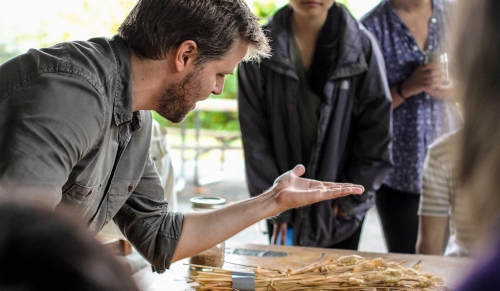
Leo Tolstoy, his long beard white, stood beside a horse in a photograph on a screen under the Yale Farm’s Lazarus Pavilion. A second image showed an aerial photograph of the author’s estate, Yasnaya Polyana. A bungee cord tied to a cinderblock anchored the screen against gusty wind. Rain pattered against leaves.
It was not the nicest day for a wheat-threshing lesson, but 19th-century Russian peasants never got to take a rain check. Fifteen students were seated on wooden benches around two large tables. One of the tables bore four bunches of wheat and a skep hive of coiled straw.
The class, “Ecology and Russian Culture,” is co-led by Molly Brunson, associate professor of Slavic languages and literatures and a member of the European Studies Council at the MacMillan Center, and Isabel Lane, a doctoral candidate and teaching fellow in the same department. The course covers Russian literature, art, and film from the 19th century onward. Several class sessions are held at the farm and involve hands-on activities led by Jeremy Oldfield, manager of field academics for the Yale Sustainable Food Program (YSFP). In this session, based on the theme “The Estate and the Landowner,” the students threshed and winnowed wheat.

